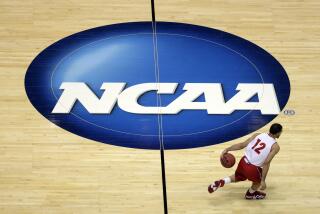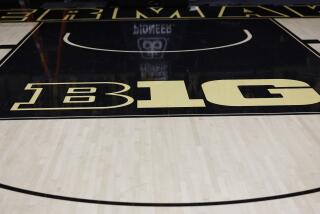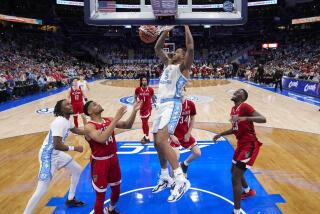ANALYSIS : COLLEGE BASKETBALL / NCAA MEN’S CHAMPIONSHIP GAME : How to Make a Great Event a Greater Event
- Share via
NEW ORLEANS — OK, so the ratings improve every year and office pools grow and even Aunt Martha and Uncle Fred can discuss the intricacies of Dean Smith’s run-and-jump defense. But that doesn’t mean a beautiful creation such as the NCAA basketball tournament can’t be improved. If not for that philosophy, all those plastic surgeons in Hollywood would be out of business pronto.
So here is our version of hoops plastic surgery. A little cut there, a bit of face lift there, a tuck for good measure and, presto, what’s great now is made even more magnificent. Do we expect the NCAA powers-to-be to listen? You betcha. After all, this is all done in a healthy spirit, placed under the category labeled constructive criticism.
Our aim is to turn this into a more open tournament, played at more sane hours with some rules adjustments directed toward increasing fairness to the players and enjoyment to the fans. To make its championship extravaganza better than ever, the NCAA should:
Open the tournament to every eligible major college. That’s right, no more selection committee, no more bubble teams, no more politics. Well, let’s not get too optimistic. Still, why not let everyone go after the title? It would add one more weekend to the tournament, but it also would eliminate those meaningless end-of-season conference tournaments.
Those league playoffs now are serving to disrupt the existing 64-team tournament by making it possible for some mediocre schools to qualify (by winning conference tournaments), thus forcing the elimination from the field of more deserving teams. With an everyone’s-eligible event, you get rid of such shenanigans. And the only politics involved would revolve around seeding of squads in the four regions. Still need to do that, but that is a lot less controversial than the current selection process.
Con: Bob Knight would like the field decreased to 32; he says that serves to reward the very best teams instead of having too many schools around that don’t have a chance of winning the title. Advocates of maintaining a 64-team tournament argue that allowing any more schools into the event dilutes the quality of the event. And what is wrong with a bubble team or two?
No home-state sites for any team. The NCAA won’t allow schools to play on their home courts. Let’s take it a step further. Send ‘em out of state. Anytime the University of North Carolina plays inside the Tar Heel State, it’s an advantage for Smith and Co. The crowd will be pro-Heels, and that isn’t fair to their opponents. Why should any team in the tournament enjoy a built-in edge? Two examples this year: Florida State played its opening-round games in Orlando, Fla.; Wake Forest advanced to the Southeast Regional in Charlotte, N.C.
Con: Early-round games don’t always draw that well, so by placing home-state teams
into some of the arenas, it improves attendance.
Employ instant replay at the end of games. Now, before you start yelping about this one, calm down and listen. We aren’t talking carte blanche replay. Just limited use, strictly involving the time clock in the final minute. Did the guy get off the shot within the rules or not? That simple.
The officials ought to have the option of viewing replay, to make sure the call is correct in these crucial moments. Use of replay for the whole game is too cumbersome, but it’s not fair for a team to win -- or lose -- at the end because of a bad ruling. And by limiting it to the final minute, we are reducing possible delays to a minimum. In both the UCLA-Michigan and North Carolina-Cincinnati games during this tournament, we had classic examples of the need for this replay rule.
Con: The old grudge against replay: You shouldn’t eliminate human error from the mix. The officials may not be perfect, but technology shouldn’t interfere with their work. And who says even replay can determine the absolutely correct call?
Stop the clock after made baskets. Again, this applies only to ends of games. Adopt the NBA rule: In the last two minutes, stop the clock after every made field goal. This would eliminate the need for all those end-of-game timeouts that are called mostly just to get the clock stopped. You don’t see any of that in the NBA, which is one reason pro games, even in the playoffs, don’t go on forever and ever. Believe it or not, sometimes it takes 10 or 15 minutes to play the last couple of minutes of college games. That’s because television crams in two-minutes-plus of ads during each of those timeouts. Such a waste, considering a simple rule change could make things so much more interesting.
Con: It’s a great game, so why mess with it? Besides, there always should be some rule differences between the colleges and the pros. But while we are talking about TV timeouts . . .
Curb the length of timeouts. CBS is paying $1 billion for the rights to the tournament, which means it needs to sell a whole lot of advertising. Which means the flow of games is being disrupted by lengthy breaks for those seemingly endless commercials. At some tournament contests this year, fans booed while players stood on the court, waiting for CBS to return to live action. Maybe the NCAA could accept a little less money next time and maintain more control over its games.
Con: For $1 billion, adding 30 to 60 seconds per timeout is a small price to pay in return.
Start late games a lot earlier. Some late games begin after 10 p.m. local time. “Too late, much too late,” Knight says, and we have to agree. No game should begin after 9:30 p.m., unless overtime in the first game messes up the schedule. Again, the fine hand of television enters the picture. CBS helps determine starting times, to fit into its production schedule. Forget the fact some tournament games are ending after midnight.
Con: The NCAA should be willing to make some accommodations for the network.
Play the Final Four in domes only. Granted, domes remove the intimacy from basketball games, but there is a practical side to this suggestion. Putting the Final Four in domes allows more fans to obtain tickets. Since it still isn’t too late to remember this should be a tournament to also benefit fans, let’s try to satisfy as many ticket-seekers as possible. Besides, Final Fours played in normal-sized arenas play into the hands of scalpers, who are really the only ones who profit from domeless Final Fours.
Con: Traditional arenas deserve to play host to an occasional Final Four, because they represent the best atmosphere in which to watch a game. Besides, the limited number of domes reduces the NCAA’s ability to move the event to enough geographical locations.
More to Read
Go beyond the scoreboard
Get the latest on L.A.'s teams in the daily Sports Report newsletter.
You may occasionally receive promotional content from the Los Angeles Times.










